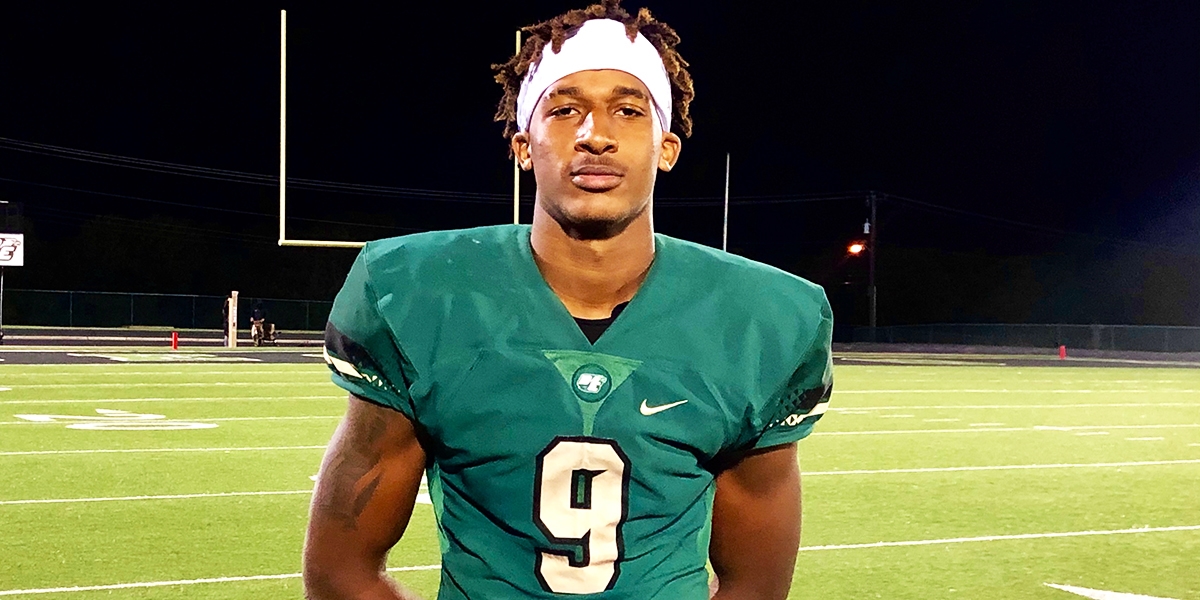Like fellow 2025 transfer addition Caleb Medford, Jerand Bradley honed his football skills in Texas, excelling at Desoto High School, a powerhouse in South Dallas. A composite three-star recruit (86), Bradley was viewed as a four-star talent by ESPN. His rankings included the 78th overall receiver, the 82nd-best player in Texas, and the 532nd-best recruit in the 2021 class. Despite his mid-tier ranking, he received offers from Wisconsin, Nebraska, Arkansas, Baylor, SMU, and Houston, before committing to Matt Wells and Texas Tech.
His high demand stemmed from an impressive senior season, where he tallied 57 receptions, 784 yards, and 8 touchdowns. Standing at 6’5” and 200 pounds, Bradley had a prototypical receiver build, making him a dominant red-zone target while also showcasing unexpected agility in the open field. His talent earned him first-team All-District-6A honors, third-team All-State recognition, and a spot in the Under Armour All-America game.
Before transferring to Desoto, Bradley starred at John Paul II High School in Plano, Texas, a TAAPS powerhouse. As a junior in 2019, he posted 96 receptions, 1,522 yards, and 21 touchdowns, leading his team to the TAPPS Division I state title game.
Texas Tech Career: The Rise & Fall
After redshirting in 2021, playing in just four games and recording five receptions for 99 yards, Bradley made a breakout impact in 2022 as a redshirt freshman. He led Texas Tech in receptions (51), receiving yards (744), and touchdowns (6) while delivering multiple 100-yard performances. His season highlight came against Oklahoma, where he torched the Sooners’ defense for 8 receptions, 173 yards, and a touchdown, leading Texas Tech to a 51-48 victory in a high-scoring thriller.
Bradley ranked fourth in the Big 12 in receiving yards per game, sixth in touchdowns, and third in catches over 30 yards. He earned Honorable Mention All-Big 12, second-team Freshman All-American honors from The Athletic, and Academic All-Big 12 first-team recognition.
Expectations soared entering 2023, as Bradley was named to the preseason All-Big 12 Team and the Biletnikoff Award watch list. However, a season-ending injury to starting quarterback Tyler Shough after four games disrupted the offense. Bradley struggled to build chemistry with backup QB Behren Morton, leading to a significant drop in production. Despite leading Texas Tech with 51 receptions in 2022, he finished 2023 with only 36 receptions, 431 yards, and 4 touchdowns. Frustrated, he entered the transfer portal as a redshirt junior.
Boston College: A Forgettable Year
Hoping for a fresh start, Bradley transferred to Boston College in 2024, seeking a larger role in the offense. Instead, the move turned into a disaster. He finished with just 6 receptions for the season, failing to make an impact due to a rotating quarterback situation and a lack of opportunities. While he had the chance to join Kansas State earlier, he was lured to Boston College by head coach Bill O’Brien—a decision that ultimately backfired.
Realizing his mistake, Bradley entered the transfer portal again as soon as he could.

What Bradley Brings to Kansas State
Now at Kansas State, Bradley finally reunites with Matt Wells, the coach who originally recruited him to Texas Tech. At 6’5”, 220 pounds, Bradley is an instant upgrade at either the boundary or field receiver position for the Wildcats. His size, physicality, and route-running ability make him a dynamic red-zone target, but he’s more than just a jump-ball specialist. At Texas Tech, he showcased strong run-after-the-catch ability, using his long strides and deceptive agility to gain extra yards.
One of Kansas State’s biggest issues in 2024 was wide receivers coming up short on key plays. Too often, K-State’s pass-catchers failed to fight through contact, leading to missed first downs. Bradley solves that problem, as he consistently gains tough yards after the catch, refusing to go down on first contact.
Impact on the Kansas State Offense
With Bradley in the mix, Kansas State’s entire receiving corps improves. His presence allows Jaron Tibbs and returning lead receiver Jayce Brown to rotate between the slot and boundary positions, creating better matchups for the offense.
Unlike last year’s finesse-based receiving group, Kansas State now boasts a bigger, stronger, and more physically dominant unit. This shift benefits quarterback Avery Johnson, giving him more reliable targets who can win in contested situations.
Bradley’s Role in the Run Game
Beyond his pass-catching ability, Bradley is an elite downfield blocker—a crucial asset for a Wildcats team featuring two explosive running backs, Dylan Edwards and Joe Jackson. Long runs often hinge on effective blocking by receivers, and Bradley is already better in this area than any of K-State’s 2024 starters. Along with Jaron Tibbs, he significantly improves Kansas State’s ability to dominate in the run game.
Final Thoughts
Bradley’s journey has been filled with ups and downs, but Kansas State offers the perfect opportunity for redemption. His physical gifts, versatility, and experience should make him a key weapon for the Wildcats in 2025. If he lives up to his potential, Bradley could transform Kansas State’s passing attack, helping the team compete for a Big 12 title and beyond.
Leave a Reply